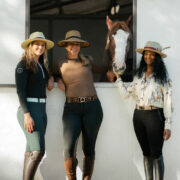Eiren Crawford: “Often In Clinics, I See Riders Working Much Too Hard”

By Eiren Crawford
Often in clinics, I see riders working much too hard, which is a major pet peeve of mine. While there are many reasons for this, my favourite is because riders haven’t realized that they have already TAUGHT the horse a skill or movement, and it’s time for them to sit back (literally sometimes) and let the horse show off what he knows.
You see it in young horses, when perhaps the transition to canter has been a struggle, but now after four months under saddle the rider is still over riding the transition, throwing her body unnecessarily in to the movement.
Recently, I was working with a solid Grand Prix combination and the rider asked if we could work on the extended trot. The horse wasn’t blessed with a natural ability to extend, and he got heavy in the contact and rushed the tempo.
After watching one diagonal, my advice to the rider was that she do less. I suggested aiding him only from the corner to the quarterline and then letting him coast. If he started to quit she could remind him to keep trying, but try to sit quietly at least until the other quarterline and give him a chance to see what he could do.
Wouldn’t you know, her horse executed a lovely, rhythmical, balanced extension from corner to corner with a lovely, light self carriage!
Because the horse had struggled for a long time with this movement, the rider felt she still had to help him and work hard to prevent mistakes. Instead, she was inadvertently pushing him out of his best balance which resulted in loss of rhythm and heavy contact.
I absolutely love when I get to see something so obvious and tell the rider to give the horse a chance and give themselves a little credit. You have done your job well! You have successfully taught the horse something, so now you can do less and let the horse show himself off.
So next time your horse is struggling in something, whether it’s a transition, a shoulder in, a collected canter, or anything else, try to do a good preparation for the movement, start it, and then LET the horse have a go. Sometimes it will fail spectacularly, but other times you might get a wonderful surprise.


